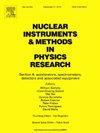Towards a Pixel TPC, Part II: Particle identification with a 32-chip GridPix detector
IF 1.4
3区 物理与天体物理
Q3 INSTRUMENTS & INSTRUMENTATION
Nuclear Instruments & Methods in Physics Research Section A-accelerators Spectrometers Detectors and Associated Equipment
Pub Date : 2025-07-22
DOI:10.1016/j.nima.2025.170849
引用次数: 0
Abstract
A Time Projection Chamber (TPC) module with 32 GridPixes was constructed and the performance was measured using data taken in a test beam at DESY in 2021. The data analysed were taken at electron beam momenta of 5 and 6 GeV/c and at magnetic fields of 0 and 1 Tesla(T). Part I of the paper has described the construction, setup and tracking results.
The or resolution for electrons in the 1 T data per metre of track length with 60% coverage was measured to be 3.6% for the truncation method and 2.9% for the template fit method using the successive distances between the hits.
The single-electron efficiency at high hit rates was studied. For hit rates up to 5.7 kHz per GridPix a reduction of at most 0.6% in the relative efficiency was measured.
Large localised hit bursts from low energetic curling electrons were characterised.
The single-electron resolution in the precision plane as a function of the local track angle was measured in the T data using reconstructed circular tracks. The resolution is – as expected – independent of the local track angle within an uncertainty of .
The projected particle identification (PID) performance for a GridPix Pixel TPC in the proposed ILD experiment at a future ILC ee collider is presented using the T test beam results for the measured electron PID resolution. The expected pion–kaon PID separation for momenta in the range of 2.5–45 GeV/c at is more than 5.5(4.5) for the template fit ( truncation) method.
迈向像素TPC,第二部分:32芯片GridPix检测器的粒子识别
构建了一个具有32个gridpix的时间投影室(TPC)模块,并使用2021年在DESY的测试光束中采集的数据测量了性能。所分析的数据是在5和6 GeV/c的电子束动量和0和1 Tesla(T)的磁场下获得的。论文的第一部分描述了本文的结构、设置和跟踪结果。在每米轨道长度1 T数据中,电子的dE/dx或dN/dx分辨率为60%,测量dE/dx截断方法为3.6%,模板拟合方法为2.9%,使用命中之间的连续距离。研究了高命中率下的单电子效率。对于每GridPix高达5.7 kHz的命中率,相对效率最多降低0.6%。低能卷曲电子产生的大范围局部撞击爆发被表征。在B=1 T数据中,使用重建的圆形轨道测量了xy精密平面上的单电子分辨率作为局部轨道角φ的函数。正如预期的那样,该分辨率与局部轨迹角无关,不确定度为16μm。在未来的ILC e+e−对撞机上,利用B=1 T测试光束的结果,给出了GridPix Pixel TPC在ILC实验中的投影粒子识别(PID)性能。对于模板拟合(dE/dx截断)方法,在成本θ=0时,动量在2.5 ~ 45 GeV/c范围内的预期π - k - k - PID分离大于5.5(4.5)σ。
本文章由计算机程序翻译,如有差异,请以英文原文为准。
求助全文
约1分钟内获得全文
求助全文
来源期刊
CiteScore
3.20
自引率
21.40%
发文量
787
审稿时长
1 months
期刊介绍:
Section A of Nuclear Instruments and Methods in Physics Research publishes papers on design, manufacturing and performance of scientific instruments with an emphasis on large scale facilities. This includes the development of particle accelerators, ion sources, beam transport systems and target arrangements as well as the use of secondary phenomena such as synchrotron radiation and free electron lasers. It also includes all types of instrumentation for the detection and spectrometry of radiations from high energy processes and nuclear decays, as well as instrumentation for experiments at nuclear reactors. Specialized electronics for nuclear and other types of spectrometry as well as computerization of measurements and control systems in this area also find their place in the A section.
Theoretical as well as experimental papers are accepted.

 求助内容:
求助内容: 应助结果提醒方式:
应助结果提醒方式:


